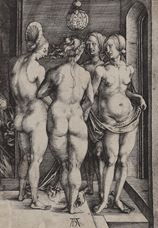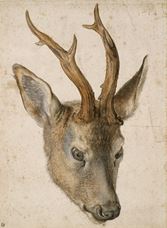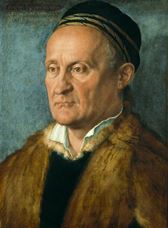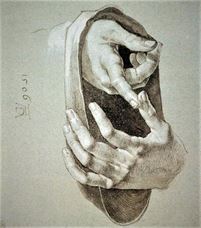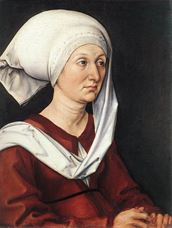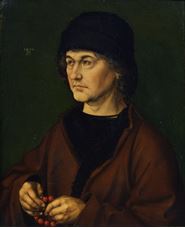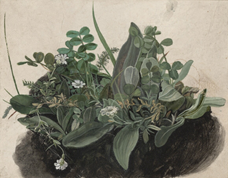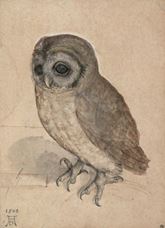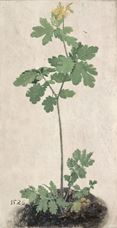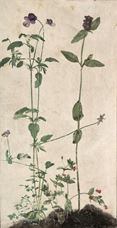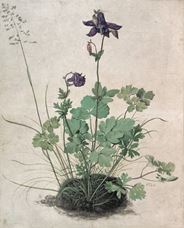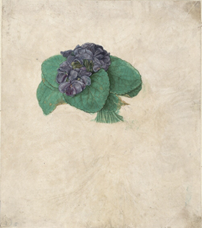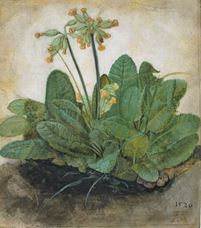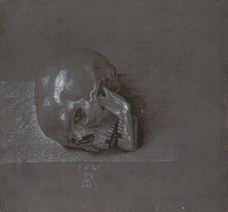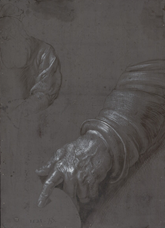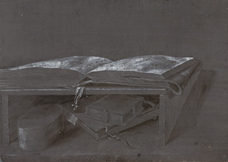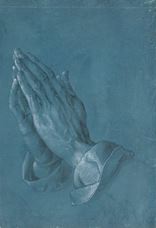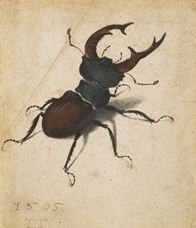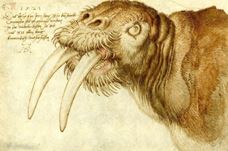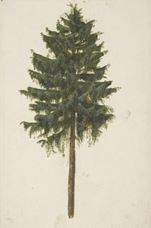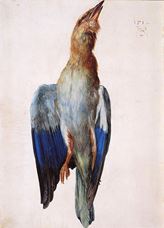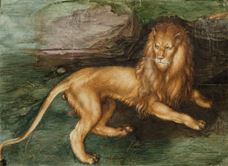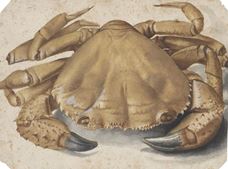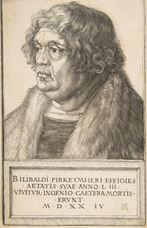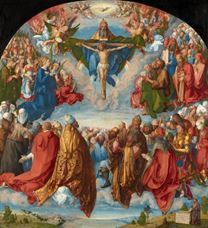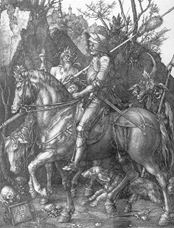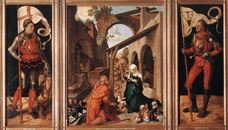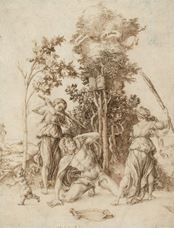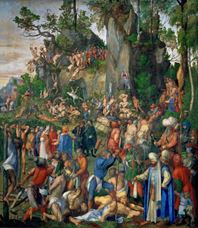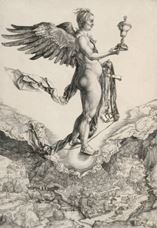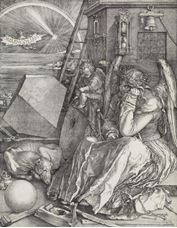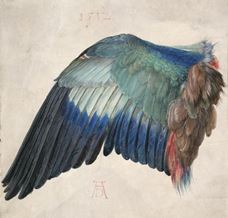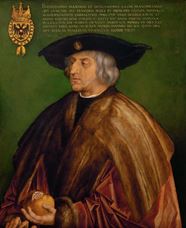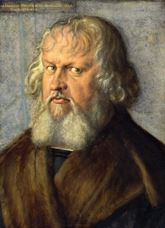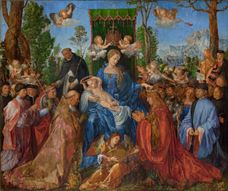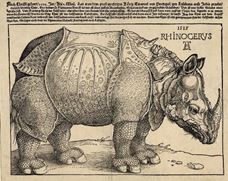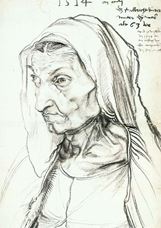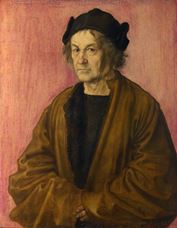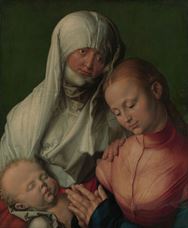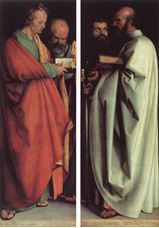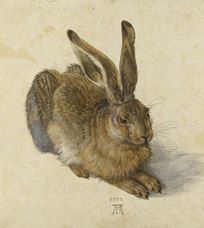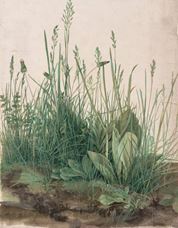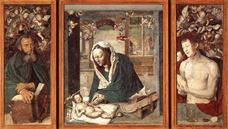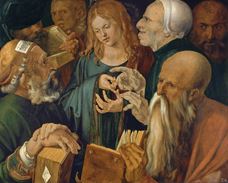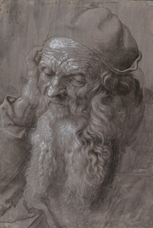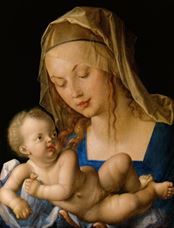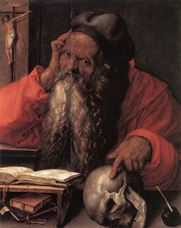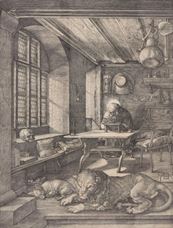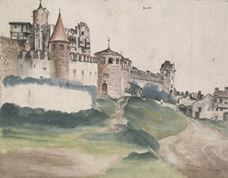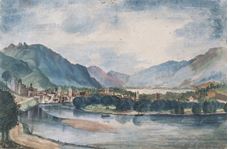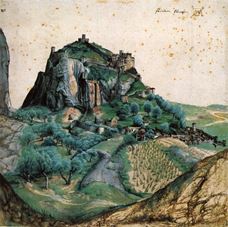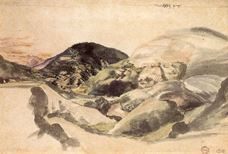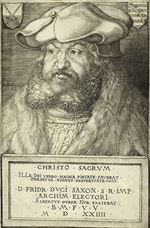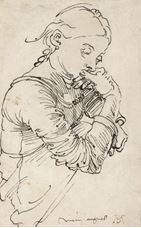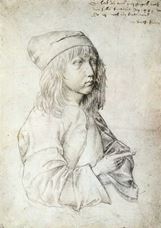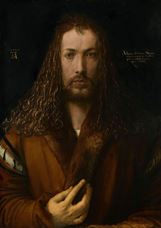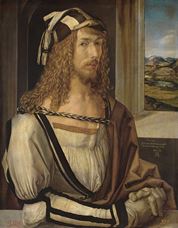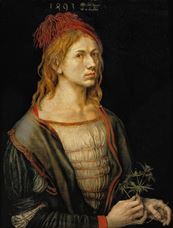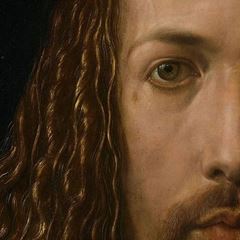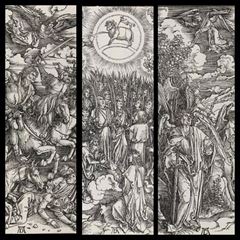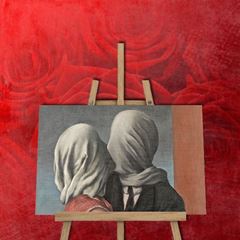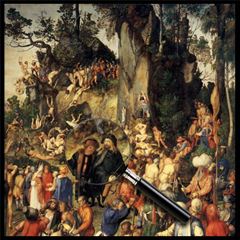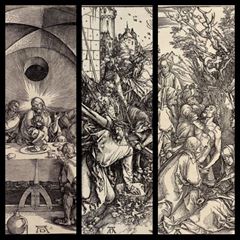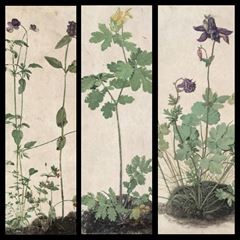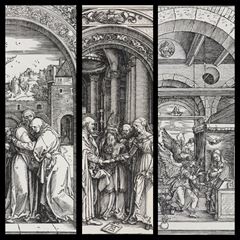Renowned painter Albrecht Dürer (1471-1528) gave his most famous works in the field of engraving and was recognized thanks to engraving. His wood-engraved engravings, in which he added a monogram to protect the copyright, also provided Dürer with a regular source of income. Dürer won his first major success in the field of engravings in 1498 by engraving "Apocalypse" (Apocalipsis cum figuris). This work was about the end of the world, "Apocalypse", in the Book of St. John Revelation in the New Testament.
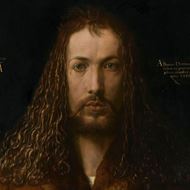
Albrecht Dürer
Albrecht Dürer was born on 21 May 1471 in Nürnberg, Germany. He was the third child of the family with 18 children. His father had emigrated from Hungary in 1455 to Germany. After his school years, Dürer started to work in 1484 in his father's jewelry store. From his father learned the basics of jewelry, drawing, and art. His outstanding talent in drawing soon emerged.
After receiving basic education from his father, At the age of 15, he started to work in the studio of Michael Wolgemut. Wolgemut was a famous painter and book illustrator of the time. He had a big painting workshop in Nuremberg. He was an apprentice alongside Wolgemut until 1489. He made oil painting portraits of his mother Barbara Dürer and his father Albrecht Dürer who had his first major work in 1490.
Dürer has gone on a long research trip to expand his horizons and gain experience. Almost four years were far from Nuremberg. He traveled to Germany, Switzerland and various regions of France. One of his goals in this trip was to visit the workshop of Martin Schongauer, the most important painter and engraver in northern Europe, and take his advice. But this meeting could not be realized due to the unexpected death of the artist. Despite his great sorrow, he went to Schangauer's atelier. He spoke with his brothers, who were painters and copper engravers.
After four years of long travel, he returned to Nuremberg in 1494. At 23 he married Agnes Fery, the daughter of a rich copper master of copper. In the same year, he made his first trip to Italy.
Dürer went to Italy through the Alps and made watercolor paintings during the trip. These works would be considered as the first landscape studies in western art. His first visit to Venice, where he first met the Italian Renaissance, was on this trip. The artistic environment of Italy, especially Venice, made a big impression on him.
In 1495 Dürer returned to Nuremberg from Italy and opened his own studio. The Italian influence was clearly seen in his works reflecting the northern tradition for five years The first works Dürer produced in his atelier were mostly religious wood carving prints.
In 1496, he became acquainted with Frederick Elector of Saxony, also known as Frederick the Wise, which had a significant impact on his life. In his official visit to Friedrich Nürnberg, he had clearly expressed his admiration for Dürer and ordered his castle in Wittenberg and a series of paintings for the church in the region. This event was the beginning of a long-lasting friendship between one of the most powerful, influential figures in German politics with long-lasting art patronage and the artist. The support of Frederick the Wise was very effective for the young and developing Dürer's art life.
Dürer, in 1497, "The Dresden Altarpiece“ altar board; In 1498, on the order of the Paumgartner family, he produced "Paumgartner Altar". Dürer included the most iconographic descriptions in his wood engraving works. In the same year, he produced the "Apocalypse" series, which included sixteen different wood engravings and the famous work "The Four Riders of the Apocalypse". The work was Dürer's first big illustration series, and he had achieved great success in the year it was published.
At the end of the 1490s, a new orientation was seen in Dürer's style. He put out an entirely original figurative model. During these years of change, he began to take orders more often than noblemen. "Portrait of Oswolt Krel" and some self-portraits appeared during this period. He made his work "The Four Witches", where he painted four women, one of the first plates. The portrait he painted from his waist updated in 1498 came to the fore among these self-portraits. Dürer was one of the first artists to make his own portrait in the history of western painting.
Dürer produced works with copper engravings at the time, although his works were focused on wooden prints and altar panels. The first years of the 1500s were a period of great development in the style of drawing. In 1502 he made the engraving of Nemesis. The third engraving, which he signed by writing his full name, was work of "Adam and Eve" which was dated 1504.
In early 1506, Dürer traveled to Italy for the second time. He stayed in Venice for a long time. Here he returned to oil painting. The engravings made by Dürer during this period also gained great popularity and started to be copied. He received great admiration among the German merchants living in Venice and received an order to make the altar ''Feast of the Rose Garlands''. Italy paved the way for Dürer to reach an artistic environment, exchange ideas with his contemporaries and develop his perspective knowledge. This travel also was a time when he focuses on his human body.
In the spring of 1507, after the second Italian period, he returned to Nuremberg. Developing friendly relations with the leading artists of the period, Dürer remained in Germany until 1520. He was now a well-known artist from all over Europe. He was also more cultured and richer. In 1509, he had his own house for the first time. In these years he was at the height of his creative power. In 1508, he did the works of "The Martyrdom of the Ten Thousand" and "The Adoration of the Trinity". The copper engraving was the most important technique Dürer used to express himself and continued to use it throughout his life.
In Dürer's life after 1512, there was another patron. I. Maximilian. Roman Emperor Maximilian I, known as the Last Knight, visited Nuremberg. He asked Dürer to enter his service. Dürer accepts the proposal and starts working as a painter of the palace. During this period he revealed his three famous works with copper engraving. These were the engravings of "Knight, Death and the Devil" in 1513 and the engravings of 1514 in "Melencolia I" and "St Jerome in his Study". He worked in his service for about seven years until the death of Roman Emperor Maximilian. He had portrayed him a year before the Emperor's death.
Dürer, who was at the height of his artistic maturity, was interested in artistic types as some craftsmanship that might be unusual for him in addition to painting and engraving. He planned the Seiren and the dragon-shaped candlesticks. He did stunning things with gold. These studies now show the style of the 40-year-old artist with different techniques, revealing his versatility and having fun at the same time. In addition to his portraits, Madonna and the Child reconsidered Jesus' work throughout his artistic life. From the Altar boards to the smallest engravings, there were many pictures of Madonna that he had drawn or worked in his 40 years of artistic life.
Dürer went to the Netherlands to attend the throne of Charles V in 1520, and to escape the plague that had begun in Nuremberg, according to others. Here, he worked as a court painter for Charles V. He saw many cities such as Brussels and Cologne. In 1521, he returned to Nuremberg with a diary he wrote during his travels. He continued to work on religious-themed engravings.
In the last years of his life, Dürer made few paintings and made portraits of his friends. He also focused his research on the theories he developed on mathematics-geometry-perspective. In these areas, he turned to articles and writings. In 1524, he published his story of the Family in which he explained his details in detail, and in 1525 his writings on geometry. In 1527, he wrote an article about the fortress and building walls that could withstand firearms. His article about human body proportions and symmetry was published in 1528.
Dürer, who completed scientific research articles and "The Four Holy Men", was now 57 years old. His last trip negatively affected his health. The disease put the artist in bed. He died on April 6, 1528.
Bibliography;
Çev:Demir, F., (2004). Artbook Dürer Alman Rönesansı'nın Büyük Ustası, Birinci Baskı, Dost Kitabevi, Ankara.
Yetkin, S.K., (2007). Büyük Ressamlar, Birinci Baskı, Palme Yayıncılık, Ankara.
Lunday, E., (2013). Büyük Sanatçıların Gizli Hayatları, Beşinci Baskı, Domingo Yayınevi, İstanbul.
Çev:Kadıoğlu, B., (2011). Albrecht Dürer, Birinci Baskı, Yapı Kredi Yayınları, İstanbul.
Gombrich, E.H., (2002). Sanatın Öyküsü, Üçüncü Baskı, Remzi Kitabevi, İstanbul.
Farthing, S., (2014). Sanatın Tüm Öyküsü, İkinci Baskı, Hayalperest Yayınevi, İstanbul.
Labno, J., (2014). Rönesans Ayrıntıda Sanat, İkinci Basım, Türkiye İş Bankası Kültür Yayınları, İstanbul.
-----------., (2007). Albrecht Dürer, Birinci Baskı, Boyut Yayın Grubu, , İstanbul.
1471 He was born in Nuremberg, Germany.
1484 He started working in his father's goldsmith's workshop. He made his first self-portrait.
1486 He started as an apprentice to Michael Wolgemut's atelier - the foremost painter of the period in Nuremberg.
1490 He made his father's portrait as his first oil painting. After his apprenticeship, he traveled for four years, covering Germany, Switzerland, and France.
1493 When he was in Strasbourg, he made his first oil painting self-portrait.
1494 When he returned to Germany, he married Agnes Frey and a few months later made his first trip to Italy.
1495 He returned to Germany with a series of watercolor paintings and opened his own studio.
1498 He produced the "Apocalypse" series, which included sixteen different wood engravings and the famous work "The Four Riders of the Apocalypse". He painted the second oil painting self-portrait.
1500 He painted the third and last oil painting self-portrait. 1502 His Father Albrecht Dürer died.
1504 He made "Adam and Eve" one of the most famous engravings. This painting was also the only picture of the present, written without shortening the name of Dürer.
1506 He made a second trip to Italy at the beginning of the year.
1507 He turned to Nuremberg as a renaissance artist contemplating, investigating and questioning.
1509 He bought his house in Tiergörtnertor in Nuremberg.
1512 He began to work as the court painter of the Roman Emperor Maximilian I.
1513 He lost his mother Barbara Dürer. He made "Knight, Death and the Devil", one of the three most important engravings.
1514 He completed the other two of the three most important engravings: "Melencolia I" and "St Jerome in his Study"
1515 He made the wooden edition called the famous "Rhinoceros". He made without seeing the animal itself, only by reading about it and looking at a simple draft.
1519 He painted the portrait of the Roman emperor Maximilian I, shortly before his death.
1520 He went to the Netherlands.
1521 He turned to Nümberg and began to grapple with malaria he had probably caught during his last trip to the Netherlands. He focused his studies on religion-themed engravings and his theories on the mathematical-geometry-perspective triangle.
1525 A geometry and perspective book on "Measuring the Line, Planes and Objects" was published in Nuremberg in 1525. This book was the first adult mathematical book in the German language.
1527 His second book "On the Defense of the Land, the Palace, and the Cities" was published.
1528 Albrecht Dürer died in Nürnberg on 6 April.
Self-Portraits - Albrecht Dürer
In his self-portraits, Dürer sometimes used a silver pen technique and subsequently added his monogram manually. Thus, it prevented the picture from being corrected later. Dürer was one of the first artists to make his own portrait in the history of western painting. Some self-portraits, which gave insight into his appearance, provided a foresight into his personality.
Lovers of Painters
The female models reflected by the painters on their paintings are the most important elements and indispensables for the painters. The female models in the masterpieces of many painters stole the hearts of the painters and then were reflected in their paintings as their lovers and wives. Examples of the spouses that add meaning to the lives and paintings of painters for February 14 Valentine's Day.
Self-Portrait in His Painting - Albrecht Dürer
Albrecht Dürer (1471-1528) is generally considered to be one of the first artists to draw self-portraits. During his working life, he made his first self-portrait series of designs and paintings at the age of thirteen. They form an idea of the inner face of their character and personality. In addition to his self-portraits, he included himself in some of his works. Albrecht Dürer described himself as distinct and distinct from others the figures in the background.
The Large Passion - Albrecht Dürer
Albrecht Dürer (1471-1528), as well as painting, was interested in etching technique and achieved a great success with this technique. He also continued to produce engravings throughout his life. The wood engravings series "Apocalypse", which he started in 1498, and "About the life of Mary" between 1501 and 1511 are counted among the important works. "The Large Passion", which uses a non-standard plate size of 39 x 28 centimeters, is another important series of wood prints. Each plate contains Latin poems that tell the death and resurrection of Jesus' last days. Dürer completed lam "The Large Passion" in 1511 and published it.
Plant Pictures - Albrecht Dürer
Nature always attracted the attention of Albrecht Dürer (1471-1528) and was the subject of his works. Dürer's works and sketches show hints that he wants to copy nature with patience and loyalty. Dürer's success in animal depictions has shown plants, grasses, and landscapes. Dürer's plant descriptions were created with a scientific sharpness that would be surprising.
Life of the Virgin - Albrecht Dürer
Albrecht Dürer (1471-1528) was known for his most famous works in the field of engraving. Wood-engraved engravings have become both a source of income and a reputation as an artist.
Dürer's engravings have been his most famous works. "The Revelation of St John (Apocalypse)", "The Large Passion" and "Life of the Virgin" were the themes of the engraving series. This series, which influenced the development of Renaissance art in Europe, has been studied by many artists.













